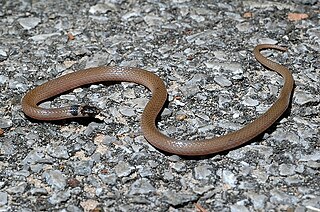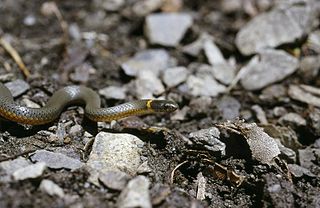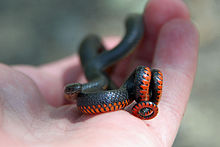
The eastern copperhead, also known simply as the copperhead, is a species of venomous snake, a pit viper, endemic to eastern North America; it is a member of the subfamily Crotalinae in the family Viperidae.

The milk snake or milksnake, is a species of kingsnake; 24 subspecies are currently recognized. Lampropeltis elapsoides, the scarlet kingsnake, was formerly classified as a 25th subspecies, but is now recognized as a distinct species. The subspecies have strikingly different appearances, and many of them have their own common names. Some authorities suggest that this species could be split into several separate species. They are not venomous to humans.

Kingsnakes are colubrid New World members of the genus Lampropeltis, which includes 26 species. Among these, about 45 subspecies are recognized. They are nonvenomous and ophiophagous in diet.

Garter snake is the common name for small to medium-sized snakes belonging to the genus Thamnophis in the family Colubridae. Native to North and Central America, species in the genus Thamnophis can be found in all of the lower 48 United States, and nearly all of the Canadian provinces south of the Northwest Territories and Nunavut—with the exception of Newfoundland and Labrador. They are found from the subarctic plains of west-central Canada east through Ontario and Quebec; from the Maritime Provinces and south to Florida, across the southern and central U.S. into the arid regions of the southwest and Mexico, Guatemala and south to the neotropics and Costa Rica.

The common garter snake is a species of snake in the subfamily Natricinae of the family Colubridae. The species is indigenous to North America and found widely across the continent. There are several recognized subspecies. Most common garter snakes have a pattern of yellow stripes on a black, brown or green background, and their average total length is about 55 cm (22 in), with a maximum total length of about 137 cm (54 in). The average body mass is 150 g (5.3 oz). The common garter snake is the state reptile of Massachusetts.

The smooth green snake is a species of North American nonvenomous snake in the family Colubridae. The species is also referred to as the grass snake. It is a slender, "small medium" snake that measures 36–51 cm (14–20 in) as an adult. It gets its common name from its smooth dorsal scales, as opposed to the rough green snake, which has keeled dorsal scales. The smooth green snake is found in marshes, meadows, open woods, and along stream edges, and is native to regions of Canada, the United States, and northern Mexico. A non-aggressive snake, it seldom bites and usually flees when threatened. It mates in late spring to summer, and females lay their eggs from June to September. The smooth green snake will often bob its head in order to mimic vegetation blowing in the wind.

The tiger snake is a large and highly venomous snake of southern Australia, including its coastal islands and Tasmania. These snakes are often observed and locally well known by their banding, black and yellow like a tiger, although the species can be highly variable in coloration and patterning. All populations are classified within the genus Notechis (Elapidae). Their diverse characteristics have been classified either as distinct species or by subspecies and regional variation.

Hydrodynastes gigas is a New World species of large, rear-fanged, Dipsadin snake endemic to South America. It is commonly and alternatively known as the false water cobra and the Brazilian smooth snake. The false water cobra is so named because when the snake is threatened it "hoods" as a true cobra does. Unlike a true cobra, though, it does not rear up, but remains in a horizontal position. No subspecies are currently recognized as being valid.

The timber rattlesnake, canebrake rattlesnake, or banded rattlesnake is a species of pit viper endemic to eastern North America. Like all other pit vipers, it is venomous, with a very toxic bite. C. horridus is the only rattlesnake species in most of the populous Northeastern United States and is second only to its relatives to the west, the prairie rattlesnake, as the most northerly distributed venomous snake in North America. No subspecies are currently recognized.

Diadophis punctatus regalis, commonly known as the regal ringneck snake, is a subspecies of ringneck snake endemic to the southwestern United States and northern Mexico.

Sistrurus tergeminus edwardsii, also known as the desert massasauga, is a subspecies of venomous pit viper in the family Viperidae. The subspecies is endemic to the Southwestern United States and northern Mexico. In places, its range overlaps that of S. t. tergeminus, and intergrading of the two subspecies is known.

Lampropeltis getula, commonly known as the eastern kingsnake, common kingsnake, or chain kingsnake, is a harmless colubrid species endemic to the United States and Mexico. It has long been a favorite among collectors. Nine subspecies are currently recognized, including the nominate subspecies described here.

Diadophis punctatus edwardsii, commonly known as the northern ringneck snake, is a subspecies of Diadophis punctatus, a snake in the family Colubridae. The subspecies is endemic to North America.

Diadophis punctatus arnyi, also known commonly as the prairie ringneck snake, is a subspecies of small, thin snake in the family Dipsadidae. The subspecies is native to the Midwestern United States.

The southeastern crown snake is a common species of small colubrid snake endemic to the southeastern United States.

Diadophis punctatus stictogenys, commonly known as the Mississippi ringneck snake, is a subspecies of Diadophis punctatus that is endemic to the United States.
Frjeda Blanchard, née Cobb, was an American plant and animal geneticist, the first to demonstrate Mendelian inheritance in reptiles.






















